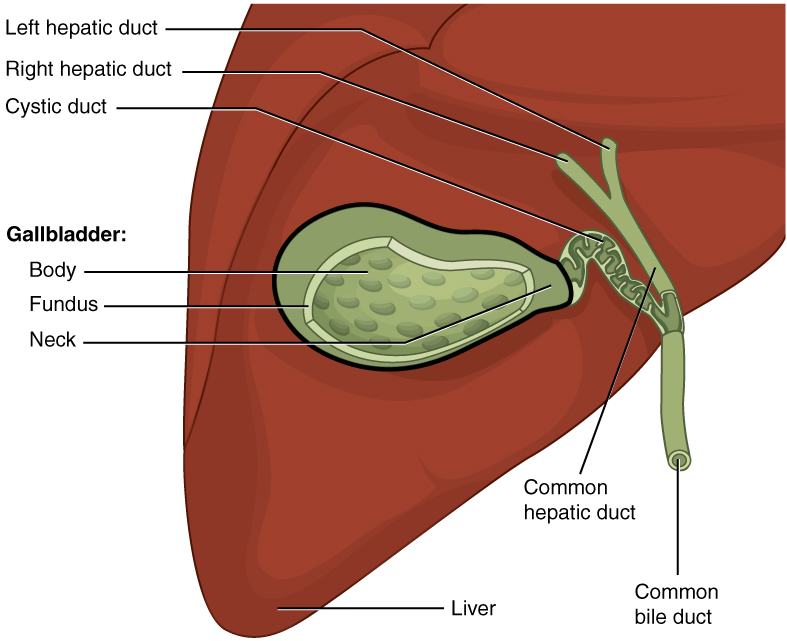Playlist
Show Playlist
Hide Playlist
Hepatobiliary – Lower Gastrointestinal Secretion
-
Slides 03 LowerGastrointestinalSecretion GastrointestinalSystem.pdf
-
Download Lecture Overview
00:01 What are in biliary secretions? Well, first there are bile salts. 00:06 There are cholesterol, lecithin, bilirubin as well as ions. 00:14 The gallbladder’s primary function is it is a storehouse of these biliary secretions, but similar to detergent, they concentrate this amount of constituents. 00:31 And it does by dehydrating what is in the gallbladder itself. 00:36 So you can concentrate that somewhere between 5 to 20%. 00:44 Okay, how do the biliary secretions get to the gallbladder? Well, they’re secreted by hepatocytes, which are liver cells. 00:51 They are collected through these small little canaliculi into terminal bile ducts, into larger bile ducts, into even larger bile ducts, until finally you get bile flow down to the gallbladder. 01:10 Now, we have these biliary constituents in the gallbladder, how do they get out into the small intestine? Well, first is done through the cystic duct. 01:22 There are some biliary secretions that are released from the right and left hepatic ducts. 01:27 These come down the common hepatic duct into the bile duct and finally out of the sphincter of Oddi. 01:37 The sphincter of Oddi will be one of primary regulatory spots in which if you relax the sphincter of Oddi, make it larger, you’re able to release the constituents from both the gallbladder and from the hepatocytes. 01:56 It’s released into the duodenum or upper part of the small intestines. 02:04 Now, how do you concentrate these substances within the gallbladder itself. 02:11 To do that, you’re going to have to undergo large amount ion exchange. 02:15 So let’s start talking through that process. 02:17 First, anytime you want to dehydrate something, which means to remove water, the first ion you need to deal with is sodium. 02:26 So sodium is exchanged with hydrogen ions, then it enters the cytosol and is removed out of the basolateral membrane by the sodium-potassium ATPase. 02:39 Now, potassium is then also allowed to move out of the cell to form a little of a circular motion to help facilitate the sodium-potassium ATPase. 02:54 Also, you’re going to have to move chloride into the cytosol. 02:58 And that is done via the exchanging of chloride for bicarbonate that enters into cytosol. 03:05 And as it enters into the cytosol, it’s allowed to leave or go through the basolateral membrane via chloride channel. 03:11 Finally, with sodium and chloride on the basolateral side of the hepatobiliary site, then you can get water movement to cross because water is only to cross the cell in response to an osmotic gradient. 03:29 And so you need to have had the sodium and chloride to be able to be moved across the cell first before the water will follow it. 03:41 So bile is constantly being produced by the liver and is transported to the gallbladder for storage, concentrated there, and then finally will be able to be released. 03:54 How it’s released is primarily in the intestinal phase. 03:59 And cholecystokinin will be the primary mediator of the release of bile from the gallbladder. 04:07 And how does it do that? Well, it first has to overcome any inhibitory effects of somatostatin and norepineprhine. 04:20 But it’s worked through this particular process. 04:22 Where bile acids are released, the sphincter of Oddi will need to be opened so that the bile acids will be able to enter the small intestine. 04:37 Cholecystokinin does two things. 04:38 One is it helps to contract the gallbladder and then relax the sphincter of Oddi. 04:44 So between those two processes, it creates enough of a pressure gradient that will have the bile flow from the gallbladder all the way out the sphincter of Oddi into the small intestine or the duodenum. 05:00 The vagus or cranial nerve number X also causes a weak stimulation of contraction of the gallbladder itself. 05:07 However, it’s not in the same level as the cholecystokinin is.
About the Lecture
The lecture Hepatobiliary – Lower Gastrointestinal Secretion by Thad Wilson, PhD is from the course Gastrointestinal Physiology.
Included Quiz Questions
Which of the following is the primary mediator that releases bile stored in the gall bladder?
- Cholecystokinin
- Norepinephrine
- Somatostatin
- Gastrin-releasing peptide
- Secretin
Which of the following is NOT a component of the biliary secretions?
- D vitamin
- Lecithin
- Bilirubin
- Bile salts
- Cholesterol
Which of the following best describes the flow of bile from the liver to the gallbladder and then the small intestines?
- Right and left hepatic duct - Common hepatic duct - Cystic duct - Gallbladder - Cystic duct - Common bile duct - Sphincter of Oddi
- Right and left hepatic duct - Common bile duct - Cystic duct - Gallbladder - Cystic duct - Common hepatic duct - Sphincter of Oddi
- Sphincter of Oddi - Right and left hepatic duct - Common hepatic duct - Cystic duct - Gallbladder - Cystic duct - Common bile duct
- Right and left hepatic duct - Common bile duct - Gallbladder - Cystic duct - Common hepatic duct - Sphincter of Oddi
- Right and left hepatic duct - Gallbladder - Common bile duct - Cystic duct - Liver - Cystic duct - Common hepatic duct - Sphincter of Oddi
Customer reviews
5,0 of 5 stars
| 5 Stars |
|
5 |
| 4 Stars |
|
0 |
| 3 Stars |
|
0 |
| 2 Stars |
|
0 |
| 1 Star |
|
0 |




